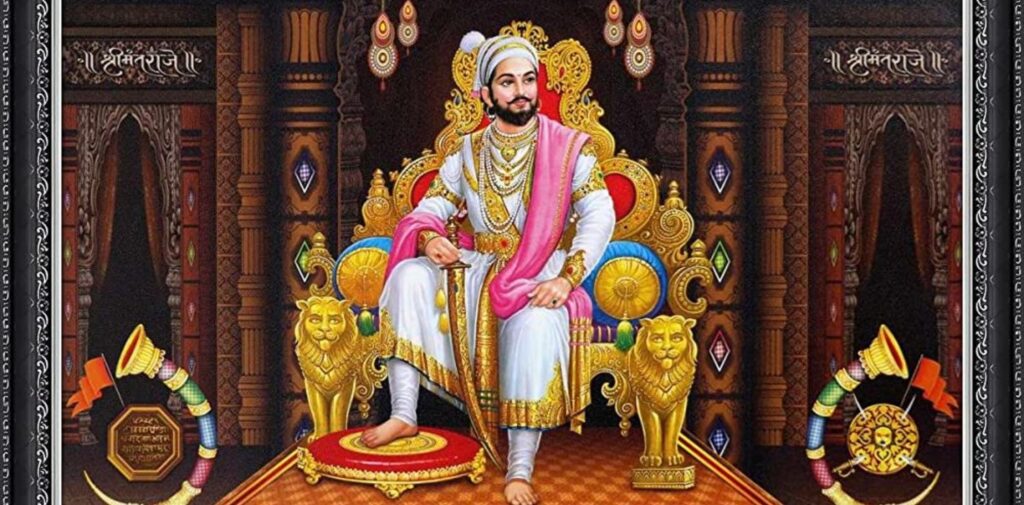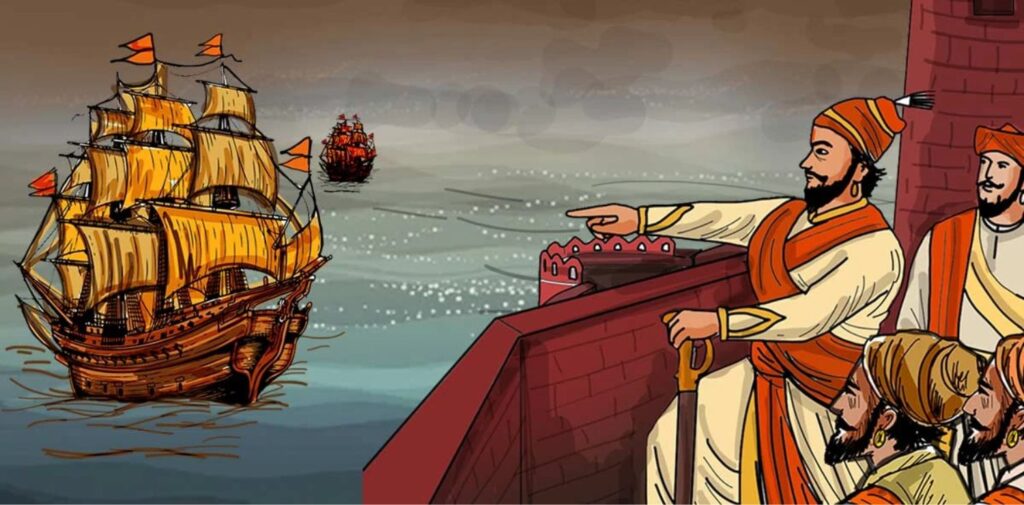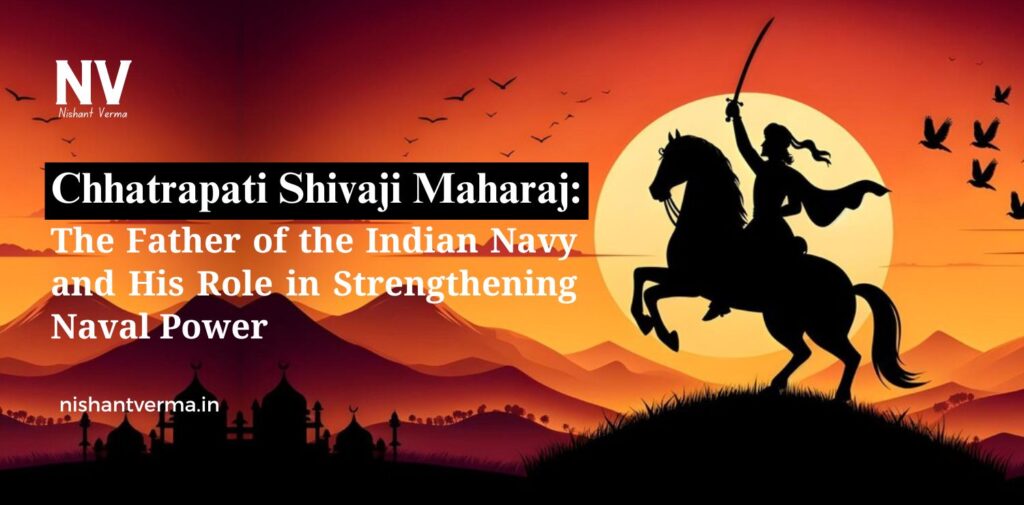Chhatrapati Shivaji Maharaj, one of India’s greatest warriors and rulers, is often referred to as the “Father of the Indian Navy.” Though he is celebrated for his incredible leadership on land, Shivaji’s vision and contributions to the naval forces of India were just as revolutionary. He recognized the importance of a strong navy long before many of his contemporaries, laying the foundation for what would become a formidable maritime force along the western coast of India. His innovations in naval warfare, shipbuilding, and naval strategy were ahead of their time, helping protect India’s coastline and securing its place in the seas for generations to come.
Early Life and the Need for a Strong Navy
Born in 1630, Shivaji Maharaj grew up in the Western Ghats, near the coastline of present-day Maharashtra. The region’s natural geography, with numerous ports, harbours, and coastal areas, made it essential to have control over the seas. During his early life, Shivaji saw frequent raids and attacks from foreign powers, especially the Portuguese and the Mughals, who controlled parts of the western coast. The absence of a powerful naval presence in the region made the coastline vulnerable to such invasions. This was one of the key reasons Shivaji realized the importance of building a strong navy.
Shivaji’s interest in naval affairs wasn’t just about defence; he saw the seas as a means to expand his empire, protect trade routes, and gain access to foreign resources. He understood that the control of the sea lanes could provide immense strategic advantages for a kingdom.

Shivaji’s Naval Vision: Laying the Foundations
Shivaji’s naval strategy was based on the idea of using a small but highly effective fleet to protect India’s coastlines. He realized that the Mughal Empire, while powerful on land, lacked a strong naval presence. To counter foreign invasions, control piracy, and ensure the safety of merchant ships, Shivaji began to establish a naval fleet with the same discipline and strategy that he used on land.
In 1657, Shivaji began to organize his navy, initially to protect the Konkan coast. By 1660, he had built a small but formidable force of ships. His first major success came in 1664 when he captured the strategic port of Khanderi and the nearby island of Underi, both of which were important for naval operations. This victory marked the beginning of Shivaji’s serious naval campaign.
Building a Powerful Fleet: Shivaji’s Naval Innovations
Shivaji’s naval force wasn’t just an army on the water—it was a well-organized, professional military unit. To create a strong navy, Shivaji focused on three key aspects: shipbuilding, naval strategy, and leadership.
- Shipbuilding and Naval Infrastructure: Shivaji’s shipbuilding efforts were remarkable for his time. He established dockyards and shipyards along the coast of Maharashtra, where ships were constructed in large numbers. The most notable of these shipyards were located in places like Surat, Mumbai, and the island of Alibaug. These regions became the heart of Shivaji’s naval operations. Shivaji’s ships were specially designed to suit the needs of coastal warfare. He built a fleet of “Gallivats,” which were smaller, fast, and agile ships suited for the narrow and treacherous waters of the western coast. These ships were highly manoeuvrable, allowing the navy to launch surprise attacks and defend the coastline effectively. Besides these smaller vessels, Shivaji also had larger warships, known as “Padavs,” which were used for heavy battles and transporting troops across seas.
- Naval Strategy and Tactics: Shivaji was a master strategist, and he applied this skill to his navy. His tactics focused on speed, surprise, and agility rather than brute strength. He was known for his daring raids along the coastlines, often attacking with smaller, faster ships before the enemy could react. This strategy allowed him to defeat larger and more powerful enemies. One of Shivaji’s most famous naval victories was the raid on the Portuguese stronghold of Diu in 1667. Though he didn’t capture the city, his naval forces succeeded in harassing and weakening the Portuguese presence, signalling the beginning of the end of Portuguese dominance along the western coast.
- Leadership and Training: Shivaji’s leadership played a crucial role in the success of his navy. He appointed capable commanders, such as Admiral Kanhoji Angre, who became one of the most feared naval leaders in India. Kanhoji Angre was responsible for maintaining discipline and effectiveness within the fleet. Shivaji also ensured that his sailors were well-trained in maritime skills and combat. The Navy was organized in a way similar to modern military organizations, with different ranks, clear commands, and a strong chain of command. Shivaji also understood the value of intelligence and espionage, which played an essential role in his naval campaigns. His network of spies provided valuable information about enemy movements and weaknesses, allowing him to plan attacks with precision.

Fortifying the Coastline: The Role of Naval Forts
One of Shivaji’s major contributions to the Indian Navy was his construction of coastal forts, which acted as strongholds and bases for naval operations. These forts were built on strategic islands and coastal locations to control maritime traffic and provide protection for the naval fleet. Some of the most notable forts built by Shivaji include:
- Sindhudurg Fort: Located on an island off the coast of Malvan, Sindhudurg was one of Shivaji’s most famous forts. It was well-fortified and designed to protect the western coastline from foreign invasions. The fort was a key naval base for Shivaji’s fleet.
- Murud-Janjira Fort: Built on a rocky island off the coast of Maharashtra, Murud-Janjira was a stronghold that remained unconquered for centuries. Even the mighty Mughals and the Portuguese were unable to capture it.
These forts were not only military bases but also symbols of Shivaji’s ability to integrate naval power with land-based defence strategies. They helped protect his kingdom from seaborne invasions, while also providing a secure base for naval expeditions.

Legacy of Shivaji’s Navy
The Indian Navy that Shivaji built was not just about ships and forts; it was an idea of naval warfare that prioritized strategic thinking, agility, and innovation. By the time of his death in 1680, Shivaji had established a formidable naval presence that would serve as a model for future generations of Indian rulers.
Shivaji’s navy played a crucial role in the defense of India’s western coast against various invaders. His efforts to protect the coastline from foreign powers like the Portuguese, Dutch, and later, the British, were crucial in maintaining India’s independence and maritime heritage. Even after his death, his naval legacy lived on, influencing future Indian rulers and naval leaders, including those who would eventually fight the British colonial powers.
Conclusion: Chhatrapati Shivaji Maharaj Enduring Influence
Chhatrapati Shivaji Maharaj’s contributions to the Indian Navy are monumental. He not only established a powerful naval fleet but also laid the foundation for naval strategy, shipbuilding, and coastal defence that would last for centuries. His legacy as the “Father of the Indian Navy” is remembered not just for the strength of his navy, but for his vision, leadership, and ability to protect his kingdom from seaborne threats. Shivaji’s naval power is a reminder of the strategic importance of the sea in Indian history and the foresight of a great leader who understood that true power lies not just in land conquests, but in controlling the waters as well.
Through his navy, Shivaji ensured that India’s coastline remained secure, and his maritime innovations inspired generations of naval strategists and leaders. Today, Shivaji’s naval legacy continues to be a source of inspiration, particularly for India’s modern Navy, which stands as a testament to his enduring vision and foresight.




